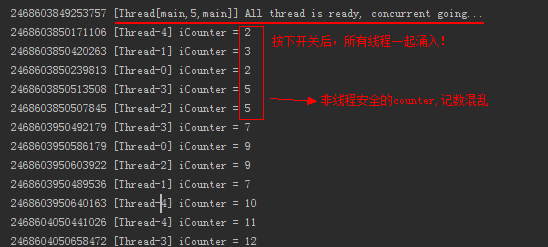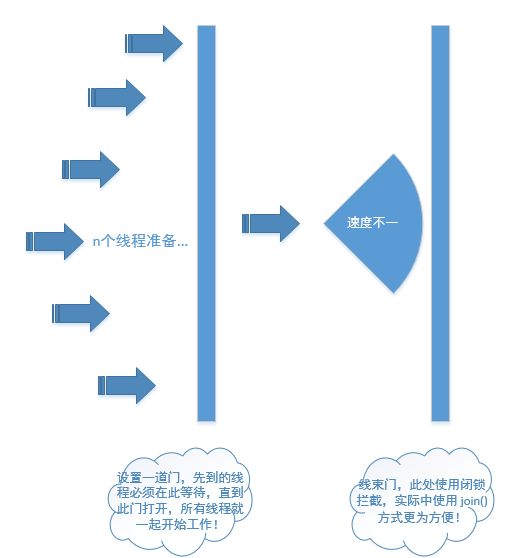作者:等你归去来
链接:www.cnblogs.com/yougewe
有时需要测试一下某个功能的并发性能,又不要想借助于其他工具,索性就自己的开发语言,来一个并发请求就最方便了。
java中模拟并发请求,自然是很方便的,只要多开几个线程,发起请求就好了。但是,这种请求,一般会存在启动的先后顺序了,算不得真正的同时并发!
怎么样才能做到真正的同时并发呢?
是本文想说的点,java中提供了闭锁 CountDownLatch, 刚好就用来做这种事就最合适了。
只需要:
-
开启n个线程,加一个闭锁,开启所有线程;
-
待所有线程都准备好后,按下开启按钮,就可以真正的发起并发请求了。
package com.test;
import java.io.BufferedReader;
import java.io.IOException;
import java.io.InputStream;
import java.io.InputStreamReader;
import java.io.OutputStream;
import java.net.HttpURLConnection;
import java.net.MalformedURLException;
import java.net.URL;
import java.util.concurrent.CountDownLatch;
public class LatchTest {
public static void main(String[] args) throws InterruptedException {
Runnable taskTemp = new Runnable() {
// 注意,此处是非线程安全的,留坑
private int iCounter;
@Override
public void run() {
for(int i = 0; i < 10; i++) {
// 发起请求
// HttpClientOp.doGet("https://www.baidu.com/");
iCounter++;
System.out.println(System.nanoTime() + " [" + Thread.currentThread().getName() + "] iCounter = " + iCounter);
try {
Thread.sleep(100);
} catch (InterruptedException e) {
e.printStackTrace();
}
}
}
};
LatchTest latchTest = new LatchTest();
latchTest.startTaskAllInOnce(5, taskTemp);
}
public long startTaskAllInOnce(int threadNums, final Runnable task) throws InterruptedException {
final CountDownLatch startGate = new CountDownLatch(1);
final CountDownLatch endGate = new CountDownLatch(threadNums);
for(int i = 0; i < threadNums; i++) {
Thread t = new Thread() {
public void run() {
try {
// 使线程在此等待,当开始门打开时,一起涌入门中
startGate.await();
try {
task.run();
} finally {
// 将结束门减1,减到0时,就可以开启结束门了
endGate.countDown();
}
} catch (InterruptedException ie) {
ie.printStackTrace();
}
}
};
t.start();
}
long startTime = System.nanoTime();
System.out.println(startTime + " [" + Thread.currentThread() + "] All thread is ready, concurrent going...");
// 因开启门只需一个开关,所以立马就开启开始门
startGate.countDown();
// 等等结束门开启
endGate.await();
long endTime = System.nanoTime();
System.out.println(endTime + " [" + Thread.currentThread() + "] All thread is completed.");
return endTime - startTime;
}
}
其执行效果如下图所示:

httpClientOp 工具类,可以使用 成熟的工具包,也可以自己写一个简要的访问方法,参考如下:
class HttpClientOp {
public static String doGet(String httpurl) {
HttpURLConnection connection = null;
InputStream is = null;
BufferedReader br = null;
String result = null;// 返回结果字符串
try {
// 创建远程url连接对象
URL url = new URL(httpurl);
// 通过远程url连接对象打开一个连接,强转成httpURLConnection类
connection = (HttpURLConnection) url.openConnection();
// 设置连接方式:get
connection.setRequestMethod("GET");
// 设置连接主机服务器的超时时间:15000毫秒
connection.setConnectTimeout(15000);
// 设置读取远程返回的数据时间:60000毫秒
connection.setReadTimeout(60000);
// 发送请求
connection.connect();
// 通过connection连接,获取输入流
if (connection.getResponseCode() == 200) {
is = connection.getInputStream();
// 封装输入流is,并指定字符集
br = new BufferedReader(new InputStreamReader(is, "UTF-8"));
// 存放数据
StringBuffer sbf = new StringBuffer();
String temp = null;
while ((temp = br.readLine()) != null) {
sbf.append(temp);
sbf.append("\r\n");
}
result = sbf.toString();
}
} catch (MalformedURLException e) {
e.printStackTrace();
} catch (IOException e) {
e.printStackTrace();
} finally {
// 关闭资源
if (null != br) {
try {
br.close();
} catch (IOException e) {
e.printStackTrace();
}
}
if (null != is) {
try {
is.close();
} catch (IOException e) {
e.printStackTrace();
}
}
connection.disconnect();// 关闭远程连接
}
return result;
}
public static String doPost(String httpUrl, String param) {
HttpURLConnection connection = null;
InputStream is = null;
OutputStream os = null;
BufferedReader br = null;
String result = null;
try {
URL url = new URL(httpUrl);
// 通过远程url连接对象打开连接
connection = (HttpURLConnection) url.openConnection();
// 设置连接请求方式
connection.setRequestMethod("POST");
// 设置连接主机服务器超时时间:15000毫秒
connection.setConnectTimeout(15000);
// 设置读取主机服务器返回数据超时时间:60000毫秒
connection.setReadTimeout(60000);
// 默认值为:false,当向远程服务器传送数据/写数据时,需要设置为true
connection.setDoOutput(true);
// 默认值为:true,当前向远程服务读取数据时,设置为true,该参数可有可无
connection.setDoInput(true);
// 设置传入参数的格式:请求参数应该是 name1=value1&name2=value2 的形式。
connection.setRequestProperty("Content-Type", "application/x-www-form-urlencoded");
// 设置鉴权信息:Authorization: Bearer da3efcbf-0845-4fe3-8aba-ee040be542c0
connection.setRequestProperty("Authorization", "Bearer da3efcbf-0845-4fe3-8aba-ee040be542c0");
// 通过连接对象获取一个输出流
os = connection.getOutputStream();
// 通过输出流对象将参数写出去/传输出去,它是通过字节数组写出的
os.write(param.getBytes());
// 通过连接对象获取一个输入流,向远程读取
if (connection.getResponseCode() == 200) {
is = connection.getInputStream();
// 对输入流对象进行包装:charset根据工作项目组的要求来设置
br = new BufferedReader(new InputStreamReader(is, "UTF-8"));
StringBuffer sbf = new StringBuffer();
String temp = null;
// 循环遍历一行一行读取数据
while ((temp = br.readLine()) != null) {
sbf.append(temp);
sbf.append("\r\n");
}
result = sbf.toString();
}
} catch (MalformedURLException e) {
e.printStackTrace();
} catch (IOException e) {
e.printStackTrace();
} finally {
// 关闭资源
if (null != br) {
try {
br.close();
} catch (IOException e) {
e.printStackTrace();
}
}
if (null != os) {
try {
os.close();
} catch (IOException e) {
e.printStackTrace();
}
}
if (null != is) {
try {
is.close();
} catch (IOException e) {
e.printStackTrace();
}
}
// 断开与远程地址url的连接
connection.disconnect();
}
return result;
}
}
如上,就可以发起真正的并发请求了。
并发请求操作流程示意图如下:

此处设置了一道门,以保证所有线程可以同时生效。但是,此处的同时启动,也只是语言层面的东西,也并非绝对的同时并发。具体的调用还要依赖于CPU个数,线程数及操作系统的线程调度功能等,不过咱们也无需纠结于这些了,重点在于理解原理!
与 CountDownLatch 有类似功能的,还有个工具栅栏 CyclicBarrier, 也是提供一个等待所有线程到达某一点后,再一起开始某个动作,效果一致,不过栅栏的目的确实比较纯粹,就是等待所有线程到达,而前面说的闭锁 CountDownLatch 虽然实现的也是所有线程到达后再开始,但是他的触发点其实是 最后那一个开关,所以侧重点是不一样的。
简单看一下栅栏是如何实现真正同时并发呢?示例如下:
// 与 闭锁 结构一致
public class LatchTest {
public static void main(String[] args) throws InterruptedException {
Runnable taskTemp = new Runnable() {
private int iCounter;
@Override
public void run() {
// 发起请求
// HttpClientOp.doGet("https://www.baidu.com/");
iCounter++;
System.out.println(System.nanoTime() + " [" + Thread.currentThread().getName() + "] iCounter = " + iCounter);
}
};
LatchTest latchTest = new LatchTest();
// latchTest.startTaskAllInOnce(5, taskTemp);
latchTest.startNThreadsByBarrier(5, taskTemp);
}
public void startNThreadsByBarrier(int threadNums, Runnable finishTask) throws InterruptedException {
// 设置栅栏解除时的动作,比如初始化某些值
CyclicBarrier barrier = new CyclicBarrier(threadNums, finishTask);
// 启动 n 个线程,与栅栏阀值一致,即当线程准备数达到要求时,栅栏刚好开启,从而达到统一控制效果
for (int i = 0; i < threadNums; i++) {
Thread.sleep(100);
new Thread(new CounterTask(barrier)).start();
}
System.out.println(Thread.currentThread().getName() + " out over...");
}
}
class CounterTask implements Runnable {
// 传入栅栏,一般考虑更优雅方式
private CyclicBarrier barrier;
public CounterTask(final CyclicBarrier barrier) {
this.barrier = barrier;
}
public void run() {
System.out.println(Thread.currentThread().getName() + " - " + System.currentTimeMillis() + " is ready...");
try {
// 设置栅栏,使在此等待,到达位置的线程达到要求即可开启大门
barrier.await();
} catch (InterruptedException e) {
e.printStackTrace();
} catch (BrokenBarrierException e) {
e.printStackTrace();
}
System.out.println(Thread.currentThread().getName() + " - " + System.currentTimeMillis() + " started...");
}
}
其运行结果如下图:

各有其应用场景吧,关键在于需求。就本文示例的需求来说,个人更愿意用闭锁一点,因为更可控了。但是代码却是多了,所以看你喜欢吧!
近期热文推荐:
1.1,000+ 道 Java面试题及答案整理(2021最新版)
2.别在再满屏的 if/ else 了,试试策略模式,真香!!
3.卧槽!Java 中的 xx ≠ null 是什么新语法?
4.Spring Boot 2.5 重磅发布,黑暗模式太炸了!
觉得不错,别忘了随手点赞+转发哦!